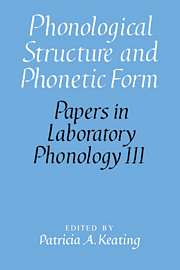Book contents
- Frontmatter
- Contents
- List of contributors
- Acknowledgments
- 1 Introduction
- I Intonation
- II Syllables
- III Feature Theory
- IV Phonetic Output
- 16 Phonetic evidence for sound change in Quebec French
- 17 Polysyllabic words in the YorkTalk synthesis system
- 18 Phonetic arbitrariness and the input problem: comments on Coleman's paper
- 19 Lip aperture and consonant releases
- 20 Change and stability in the contrasts conveyed by consonant releases
- Index of subjects
- Index of names
20 - Change and stability in the contrasts conveyed by consonant releases
Published online by Cambridge University Press: 26 February 2010
- Frontmatter
- Contents
- List of contributors
- Acknowledgments
- 1 Introduction
- I Intonation
- II Syllables
- III Feature Theory
- IV Phonetic Output
- 16 Phonetic evidence for sound change in Quebec French
- 17 Polysyllabic words in the YorkTalk synthesis system
- 18 Phonetic arbitrariness and the input problem: comments on Coleman's paper
- 19 Lip aperture and consonant releases
- 20 Change and stability in the contrasts conveyed by consonant releases
- Index of subjects
- Index of names
Summary
Introduction
This commentary on Browman's paper explores the phonetics and phonology of two interactions between a consonant's release and the nature of the following sound. In the first interaction, a following vowel's place of articulation alters the consonant's, while in the second, the following sound's openness determines whether the consonant contrasts for laryngeal and other articulations. Both interactions come about because the following context influences the spectrum and/or audibility of the consonant's release. Browman's data show that the blending of vocalic and consonantal Gestures affecting lip aperture should produce different effects on the acoustics of the consonant's release in [p] than in [t, s, k], which may explain differences between labials and nonlabials in their susceptibility to assimilation to the place of adjacent vowels. These differences are explored in section 2 of this commentary, through examination of pervasive consonant-to-vowel place assimilations in Bantu languages. Browman argues that active release Gestures are necessary to achieve a sufficiently open vocal tract to produce a vowel after a stop closure. Section 3 of this commentary summarizes a variety of data suggesting that many consonantal contrasts depend on, or are best conveyed by, the release of an oral closure into an open vocal-tract configuration, and thus that an active release might be essential for conveying these contrasts.
Changes in place
Consonants' place of articulation is frequently altered by assimilation to the place of adjacent, particularly following, vowels.
- Type
- Chapter
- Information
- Phonological Structure and Phonetic Form , pp. 354 - 361Publisher: Cambridge University PressPrint publication year: 1994



